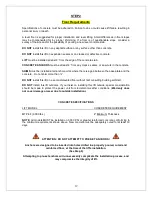
26
MAINTENANCE
DAILY MAINTENANCE
1] Give the lift a quick once-over before using it each day. Check for any obvious leaks, or
defects. Inspect cables, hoses and chains for any sign of wear.
2] Verify lift is operating properly, raising levelly and all locking mechanisms for the arms and
carriages are working.
WEEKLY MAINTENANCE
1] Lubricate all chain rollers and cable pulleys. Grease the carriage tracks inside the towers.
2] Check all nuts and bolts; tighten where necessary.
3] After the first week, check cable tension and adjust as necessary. Check every 6 months after.
MONTHLY MAINTENANCE
1] Check and lubricate all safety mechanisms; ensure they are in proper working order. Replace
any worn or defective parts.
2] Check and tighten anchor bolts as necessary.
3] Inspect all moving parts; replace any worn or defective parts.
CABLE INSPECTION AND MAINTENANCE
1] Lift cables normally require replacement every four to five years.
2] Lift cables should be replaced if you see three or more broken wires in one strand.
3] Replace the cables if you see: corrosion or rusting on the wires or ends, kinking, crushed
areas, cutting, spreading, a cable core protruding, or any other abnormality.
4] If any cable defects are found the lift should be shut down immediately until the defective
cable(s) have been replaced.
5] Cables and other lift parts should be kept free of corrosive agents, solvents, and
road salt. If such agents are spilled or splashed on any lift component, immediately rinse and
wipe down with a clean rag. Spray cables every three months with Penetrating Oil and wipe
down. Failure to keep cables free of corrosive agents will lead to reduced service life, cable
failure, etc. which could result in property damage and/or personal injury.
1] If ANY component of the lift is found to be defective, DO NOT USE LIFT!
2] NEVER operate the lift with any person or equipment below.
3] ALWAYS stand clear of lift when raising or lowering.
4] NEVER exceed rated capacity.
5] ALWAYS ensure safeties are engaged before working on or near vehicle.
6] NEVER leave lift in an elevated position unless it is settled firmly on the safety locks.
7] NEVER attempt to back a vehicle onto an asymmetric lift.







































